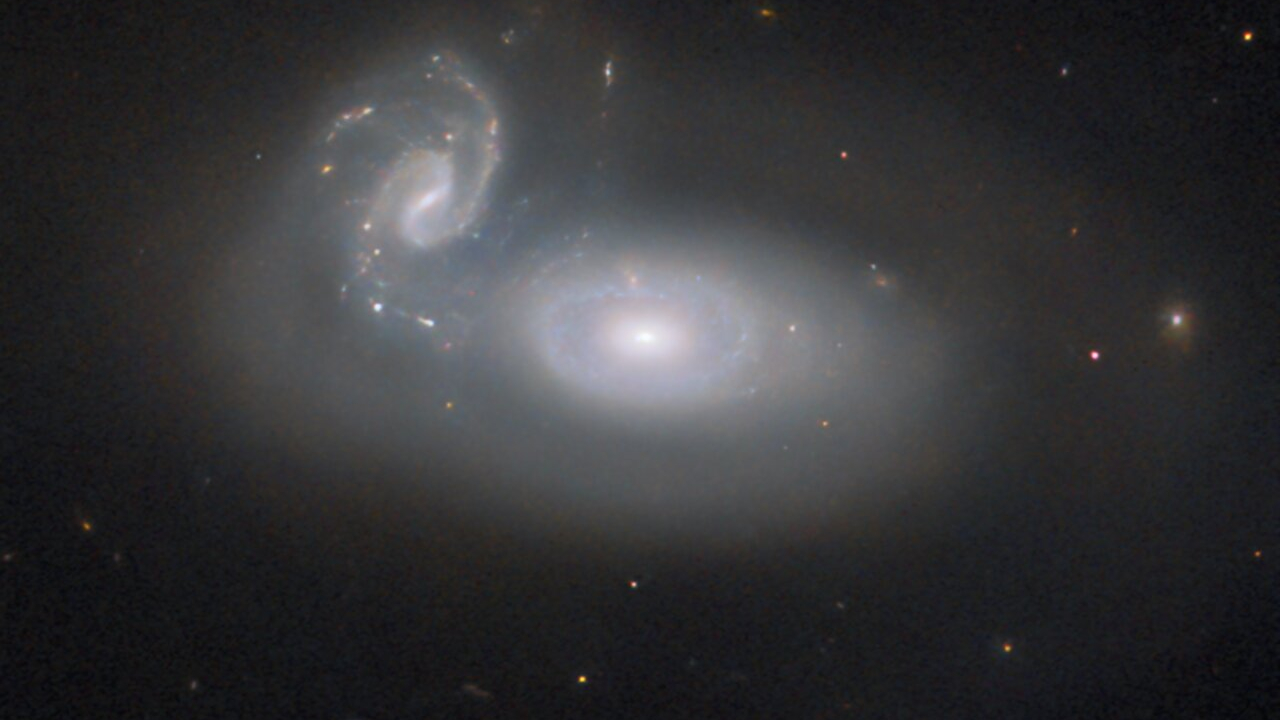Galaxies get tangled up in 'the queen's hair' in new Hubble Telescope image
'This process won't be complete for many millions of years — until then, Queen Berenice II will have to suffer the knots in her hair!'

The Hubble Space Telescope has captured two tangled galaxies, whose interactions have caused knots to form in the "queen's hair."
The galactic duo, formally known as MCG+05-31-045, is located 390 million light-years away in the constellation Coma Berenices, which means "Berenice's Hair" in Latin and refers to Queen Berenice II, a ruler of Ptolemaic Egypt more than 2,000 years ago. The larger elliptical galaxy is pulling material from a smaller neighboring galaxy, distorting its spiral arms.
In turn, the teased strands of interstellar material fuels new star formation in the larger galaxy, while the smaller companion will eventually be left with only aging stars and little to no gas, according to a statement from the European Space Agency (ESA). (Hubble is a joint mission of NASA and ESA.)
"But this process won't be complete for many millions of years — until then, Queen Berenice II will have to suffer the knots in her hair!" ESA officials said in the statement, which accompanied the new Hubble image.
Related: Hubble Space Telescope tells a starry 'tail' of 12 mingling galaxies
The larger elliptical galaxy can be seen in the center of the new Hubble image, with an overall oval shape and bright core. Located left of this galaxy is a smaller companion with two distinct spiral arms. A faint stream of material with a few glowing spots can be seen flowing between the two galaxies, connecting one of the spiral arms to the larger elliptical galaxy.
The pair of tangled galaxies belong to a larger group known as the Coma galaxy cluster. Many galaxies in this cluster have undergone similar processes of merging with larger companions.
Get the Space.com Newsletter
Breaking space news, the latest updates on rocket launches, skywatching events and more!
The Coma cluster is densely packed with over 1,000 known galaxies, several of which can be seen scattered across the new Hubble image. Many of them are elliptical galaxies that formed following close encounters, or collisions, with another galaxy that stole all of their stellar material and distorted their neatly woven spiral arms.
Such galactic interactions can stir up interstellar gas and dust, which, when heated and compressed by a galaxy's gravitational forces, forms new stars. However, one of the galaxies is often left without enough gas to form its own next generation of young stars and its spiral arms — the site of ongoing star formation — end up in disarray. In turn, a once spiral galaxy can be transformed into one nearly devoid of gas and populated with aging stars that instead orbit in uncoordinated circles, creating a more general elliptical shape.
"It's very likely that a similar fate will befall MCG+05-31-045," ESA officials said in the statement. "As the smaller spiral galaxy is torn up and integrated into the larger galaxy, many new stars will form, and the hot, blue ones will quickly burn out, leaving cooler, redder stars behind in an elliptical galaxy much like the others in the Coma cluster."
Join our Space Forums to keep talking space on the latest missions, night sky and more! And if you have a news tip, correction or comment, let us know at: community@space.com.

Samantha Mathewson joined Space.com as an intern in the summer of 2016. She received a B.A. in Journalism and Environmental Science at the University of New Haven, in Connecticut. Previously, her work has been published in Nature World News. When not writing or reading about science, Samantha enjoys traveling to new places and taking photos! You can follow her on Twitter @Sam_Ashley13.
-
MikeMc The top of the story says that we will have to wait millions of years to see how this all plays out. I guess so, but it actually already has played out millions of years ago. We are seeing pictures of what the two galaxies looked like 390 million years ago. So in their present day location, the galaxies should have already merged together millions of years ago.Reply









